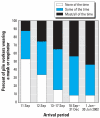Asthma diagnosed after 11 September 2001 among rescue and recovery workers: findings from the World Trade Center Health Registry
- PMID: 18007989
- PMCID: PMC2072829
- DOI: 10.1289/ehp.10248
Asthma diagnosed after 11 September 2001 among rescue and recovery workers: findings from the World Trade Center Health Registry
Abstract
Background: Studies have consistently documented declines in respiratory health after 11 September 2001 (9/11) among surviving first responders and other World Trade Center (WTC) rescue, recovery, and clean-up workers.
Objectives: The goal of this study was to describe the risk of newly diagnosed asthma among WTC site workers and volunteers and to characterize its association with WTC site exposures.
Methods: We analyzed 2003-2004 interview data from the World Trade Center Health Registry for workers who did not have asthma before 9/11 (n = 25,748), estimating the risk of newly diagnosed asthma and its associations with WTC work history, including mask or respirator use.
Results: Newly diagnosed asthma was reported by 926 workers (3.6%). Earlier arrival and longer duration of work were significant risk factors, with independent dose responses (p < 0.001), as were exposure to the dust cloud and pile work. Among workers who arrived on 11 September, longer delays in the initial use of masks or respirators were associated with increased risk of asthma; adjusted odds ratios ranged from 1.63 [95% confidence interval (CI), 1.03-2.56) for 1 day of delay to 3.44 (95% CI, 1.43-8.25) for 16-40 weeks delay.
Conclusions: The rate of self-reported newly diagnosed asthma was high in the study population and significantly associated with increased exposure to the WTC disaster site. Although we could not distinguish appropriate respiratory protection from inappropriate, we observed a moderate protective effect of mask or respirator use. The findings underscore the need for adequate and timely distribution of appropriate protective equipment and the enforcement of its use when other methods of controlling respiratory exposures are not feasible.
Keywords: World Trade Center; asthma; disaster; masks; respirators; workers.
Figures



Comment in
-
Incidence of new onset asthma after the World Trade Center disaster.Environ Health Perspect. 2008 Jul;116(7):A286. doi: 10.1289/ehp.11331. Environ Health Perspect. 2008. PMID: 18629335 Free PMC article. No abstract available.
References
-
- Brackbill R, Thorpe L, DiGrande L, Perrin M, Sapp J, Wu D, et al. Surveillance for World Trade Center disaster health effects among survivors of collapse and damaged buildings. MMWR Surveill Summ. 2006;55:1–18. - PubMed
-
- CDC (Centers for Disease Control and Prevention) Physical health status of World Trade Center rescue and recovery workers and volunteers – New York City, July 2002-August 2004. MMWR Morb Mortal Wkly Rep. 2004;53:807–812. - PubMed
-
- Dolan M, Murphy J, Thalji L, Pulliam P. World Trade Center Health Registry: Sample Building and Denominator Estimation. Chicago, IL: RTI International; 2006. [[accessed 2 October 2007]]. Available: http://www.nyc.gov/html/doh/downloads/pdf/wtc/wtc-building-denominator.pdf.
-
- Feldman D, Baron S, Bernard B, Lushniak B, Banauch G, Arcentales N, et al. Symptoms, respirator use, and pulmonary function changes among New York City firefighters responding to the World Trade Center disaster. Chest. 2004;125:1256–1264. - PubMed
Publication types
MeSH terms
Substances
LinkOut - more resources
Full Text Sources
Medical
